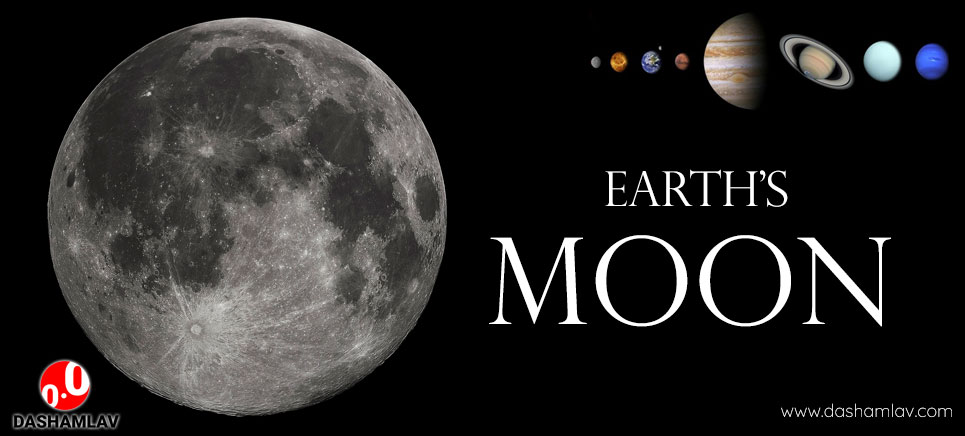We have all seen the Moon in its full beauty and its waxing and waning phases. The Moon is the only permanent natural satellite of our planet Earth. After the Sun, it is the most luminescent celestial object in our skies. Today we will learn some interesting facts about the Moon that has been a cultural icon too since the time immemorial.
1. How old is the Moon?
Moon was formed about 4.51 billion years ago. Therefore, the Moon is almost as old as the Earth, which was formed 4.54 billion years ago. Moon was formed just about 60 million years after the formation of the solar system.
2. How was the Moon formed?
It is believed that a Mars-sized object (named Theia) collided with Earth and broke it. The debris from Earth began orbit it and with time combined together to form larger moonlets. Eventually all these moonlets combined to come one body that we see today as Moon.
3. You would weigh less on the Moon
We already know that weight is measured in terms on gravitational pull exerted by a huge body. Moon’s gravity is only about 16.6% of Earth’s gravity. Therefore, your weight on the Moon will be 16.6% of how you weigh on Earth.
4. Why Moon and Sun look the same in size?
Although the Sun is much larger than the Moon, still both of these celestial bodies look roughly the same size. The reasons behind it is pretty interesting! Sun is about 400 times wider than the Moon, but it is also 400 times farther. The combined effect of these two numbers makes both Sun and the Moon look same in size.
5. We see only one side of the Moon
You might have noticed that we always see the same side of the Moon. Consequently, it appears as though the moon does not rotate at all! But that is not true. Just like the Earth, the Moon also rotates on its axis. It take 27.3 Earth days to complete a rotation on its axis — and, interestingly, it also takes the same time to complete one orbit around the Earth. This is the reason why we always see the same side of the Moon.

6. Moon’s gravity causes tides on Earth
Moon’s gravitation pull on Earth causes water level in oceans to rise and fall. Gravity of Moon creates two bulges in the oceans — one bulge appears on the Earth’s side that is facing the Moon and the other bulge is created on the opposite side of that. In these areas we see high tides, while the other areas witness the low tides.
7. Moon is a big satellite
The Moon is the closest natural satellite to the Sun because Mercury and Venus do not have any natural satellites. Moon is also the fifth largest natural satellite in the solar system. Jupiter’s satellite Ganymede is the largest natural satellite in the solar system. Then come Saturn’s satellite Titan. Third and fourth largest satellites are Callisto and Io; also belonging to Jupiter.
8. Blood Moon or Total Lunar Eclipse
A total lunar eclipse occurs when Earth completely blocks the sunlight from Moon. Totally eclipse moon appears red because the only light it reflects is the red color light refracted from the Earth’s atmosphere.
9. One day of Moon is equal to about 28 days of Earth
Moon spins on its axis really slowly. It takes 27.3 Earth days to complete one rotation on its axis. As a result, the “day period” on Moon is about two weeks long and “night period” is also about two weeks long. Neither day not a night on Moon would be comfortable for humans. The day temperature on Moon can be as high as 243 degrees Fahrenheit (117 degrees Celsius) and the night temperature can drop as low as -272 degrees Fahrenheit (-169 degrees Celsius).
10. So far, 12 men have walked on the Moon
The first one was, of course, Neil Armstrong. The second man to walk on Moon was Edwin “Buzz” Aldrin. All the 12 men, or the moonwalkers, are American astronauts. Alan Shepard was the oldest person to walk on the Moon, at age 47 years and 80 days. Harrison Schmitt and Gene Cernan spent longest time on the Moon. They remained on the lunar surface for 22 hours and 2 minutes in 1972. After 1972, no human being has landed on the Moon.
Statistics about Moon
| Property | Value |
|---|---|
| Moon’s circumference | 10921 km |
| Moon’s radius | 1737.4 km |
| Moon’s surface area | 3.793×107 km2 |
| Moon’s volume | 2.1958×1010 km3 |
| Moon’s mass | 7.342×1022 kg |
| Mean density | 3.344 g/cm3 |
| Length of solar day (single rotation on its axis) | 27.3 Earth days |
| Equatorial inclination to orbit (axial tilt) | 6.687° to orbit plane 24° to Earth’s equator |
| Rotation speed at Equator | 0.4651 km/s (1674.4 km/h; 1040.4 mph) |
| Surface gravity | 1.62 m/s2 |
| Escape velocity | 2.38 km/s |
| Satellite of | Earth |
| Moon’s composition | silica (45.5%) alumina (24.0%) lime (15.9%) iron(II) oxide (5.9%) magnesia (7.5%) titanium dioxide (0.6%) sodium oxide (0.6%) |
| Atmospheric composition | Helium Argon Neon Sodium Potassium Hydrogen Radon |
Use the citation below to add this article to your bibliography
"Moon Facts: Interesting Information on Earth’s Only Natural Satellite." Dashamlav.com. Web. 12 June 2025. <https://dashamlav.com/moon-facts-interesting-information-earth-natural-satellite/>
Dashamlav.com, "Moon Facts: Interesting Information on Earth’s Only Natural Satellite." Accessed 12 June 2025. https://dashamlav.com/moon-facts-interesting-information-earth-natural-satellite/
"Moon Facts: Interesting Information on Earth’s Only Natural Satellite." (n.d.). Dashamlav.com. Retrieved 12 June 2025 from https://dashamlav.com/moon-facts-interesting-information-earth-natural-satellite/
